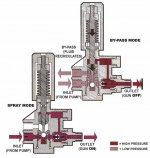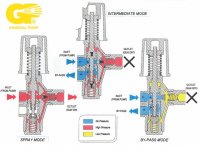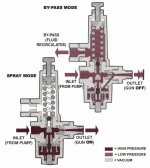The unloaders can be adjusted either way to get your desired result but according to General pump the preferred method of adjusting the Flow actuated unloader is with the trigger pulled and the Pressure actuated (trap pressure) is adjusted without the trigger pulled.
Unloaders:
There are 3 basic types of unloaders used by contractors; they are a trapped pressure unloader, flow unloader and a hydraulic compensating unloader. Unloaders may regulate pressure regulator, as well as, serve as a type of safety relief valve. When an operator releases the trigger on the gun the pump will continue to build pressure in the line. The unloader senses the pressure buildup and by opening and closing a series of internal check valves it takes the water from the pump and recirculates it back to the tank or inlet depending on how your unit is plumbed.
Trapped Pressure Unloader Valves:
Trapped pressure unloader valves are the most common and least complicated type of unloader to use. This particular style of unloader is responsive to the amount of pressure that is exerted against the bypass seat. When the trigger gun is in the open position the water flows freely from the pump through the unloader to the gun. Some bypass while in high pressure mode is normal and is even recommended on some unloaders. When the trigger is released the pump will continue to pump water increasing the pressure on the system. As the resistance builds to a point greater than the resistance of the spring the ball is forced from the bypass seat allowing the water to circulate at a minimal pressure. When this happens the unloader has an outlet check valve that is also seated that traps the pressure in the line. If there are leaks that allow this pressure to bleed off it will cause the unloader to cycle on and off.
Trapped Pressure

Hydraulic compensating

The adjustment knob on the unloader allows the operator to adjust the point at which the unloader will go into bypass mode. By increasing the tension on the spring the operator will increase the amount of force or pressure that is required to unseat the bypass ball from the seat thus increasing the pressure. Conversely when the knob or bolt is loosened it will reduce the amount of pressure required to send the unit into bypass. With the same size nozzle installed this will reduce the flow out of the unloader and in turn the nozzle. With less flow at the nozzle the pressure is reduced.
Pressure type unloaders are less sensitive to flow restrictions or nozzle changes. This means you will be able to reduce the size of your nozzles which reduces your flow and still maintaining the same pressure. When you do this the unloader will bypass the excess water that it cannot force through the nozzle at the regulated pressure.
Adjusting the trapped pressure unloader is a simple process. Remember do not try to achieve higher pressures or flows on your pump than what it is rated for, you will either damage your pump or cause serious injury to yourself or others. With the unit running, a gauge on the outlet line and a new tip sized to the desired pressure in the gun you will begin by turning the knob or nut clockwise. Continue to turn the knob until you are at the desired operating pressure. At this point you can squeeze the trigger to see of your operating pressure is the same as your bypass point. If it is lower continue to tighten the knob until the desired pressure is achieved. When the trigger is released the unit pressure should not spike more than 10% of the max rated pump pressure. If it does back the knob off to that point, when complete tighten the jam nut to lock it in place. If your operating pressure is substantially lower than the bypass point, with the correct sized nozzle, your pump may need to be serviced.
Flow Unloader Valves:
A flow type unloader valve responds to restriction or stoppage of flow between the gun and unloader. When the gun is opened the water flows freely through the line. As the water passes through the outlet port it creates a vacuum that lifts the bypass seat and closes the opening allowing for full pressure. When the trigger on the gun is released, the back pressure in the line immediately forces water back down a small channel in front of the outlet nozzle. This causes the plunger assembly with the ball form the seat of the bypass port and allows the unit to go into a bypass mode. Because there is no outlet check valve on the unloader the pressure that is in the line is allowed to bleed off the system and relive the stress on the components.

Flow unloaders will build pressure slowly over a short period of time when the trigger is pulled. This eliminates the constant pop that is typical of a trapped pressure unloader. This type unloader is very sensitive to restrictions any reduction in nozzle size, leaks or restrictions will cause it to cycle repeatedly.
Adjustment procedures on a flow type unloader are made with the unit running and the trigger pulled. With a pressure gauge on the outlet, the correct size high pressure nozzle and the trigger pulled begin tightening the top nut until you reach your desired operating pressure. Please note that on some flow unloaders the nut is turned in reverse to increase pressure. With a flow unloader it is recommended that a minimum of 10% of the water flow be in bypass for proper operation. As with the trapped pressure unloader, if your operating pressure is substantially lower than the bypass point, with the correct sized nozzle, your pump may need to be serviced.




